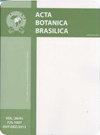葡萄青霉和葡萄青霉(欧洲菌类,子囊菌科):巴西土壤中发现的两新种
IF 1.1
4区 生物学
Q4 PLANT SCIENCES
引用次数: 0
摘要
据报道,在巴西东北部伯南布哥的一个农林业系统和一个大西洋雨林片段的土壤中发现了两种新的青霉菌。采用多相方法,结合部分β -微管蛋白(BenA)、钙调蛋白(CaM)、内转录间隔物(ITS)和RNA聚合酶II第二大亚基(RPB2)基因序列和形态特征,对11月青霉菌(Ramigena, Georgiensia系列)和葡萄青霉菌(Lanata-Divaricata, Dalearum系列)进行了研究。提供了基于形态学特征的描述。在系统发育上与乔治青霉有密切的亲缘关系;然而,P. gercinae不能在Czapek酵母提取物(CYA)上生长,并且具有单柱头和双柱头的分生孢子。青霉菌在系统发育上与penarojense和P. vanderhammenii密切相关。作为诊断特征,P. stangae在CYA(7天28-30 mm)和DG18(7天6-7 mm)上生长较慢,在肌酸琼脂上产酸不足。这项研究有助于扩大巴西青霉属物种的分类和多样性知识。本文章由计算机程序翻译,如有差异,请以英文原文为准。
Penicillium gercinae and Penicillium stangiae (Eurotiomycetes, Ascomycota), two new species from soil in Brazil
Two new Penicillium species are reported from soil of an agroforestry system and an Atlantic Rainforest fragment in Pernambuco, Northeast Brazil. Using a polyphasic approach, combining partial β -tubulin ( BenA ), calmodulin ( CaM ), internal transcribed spacer (ITS), and RNA polymerase II second largest subunit ( RPB2 ) gene sequences and morphological characters, Penicillium gercinae sp. nov. (section Ramigena , series Georgiensia ) , and Penicillium stangiae sp. nov. (section Lanata-Divaricata , series Dalearum ) are described. Descriptions based on morphological features are provided. Penicillium gercinae is phylogenetically closely related to P. georgiense ; however, P. gercinae does not grow on Czapek yeast extract (CYA) and has monoverticillate and biverticillate conidiophores. Penicillium stangiae is phylogenetically closely related to P. penarojense and P. vanderhammenii . As diagnostic features, P. stangiae had slower growth on CYA (28-30 mm in 7 days) and on DG18 (6-7 mm in 7 days) and lacked the production of acid on creatine agar. This research contributes to the expansion of knowledge on the taxonomy and diversity of Penicillium species in Brazil.
求助全文
通过发布文献求助,成功后即可免费获取论文全文。
去求助
来源期刊

Acta Botanica Brasilica
PLANT SCIENCES-
CiteScore
2.30
自引率
9.10%
发文量
32
审稿时长
6-12 weeks
期刊介绍:
Experimental, theoretical and applied papers on all aspects of plant (including algae) and fungi biology are welcome. The submitted manuscript or its essential content must not have been published previously or be under consideration for publication elsewhere. Contributions should be substantial, written in high-quality English and show general interest. We expect that the submitted manuscript presents a great novelty in Botany, and this should attract a wide audience. Considering this, case studies are only considered if the narrative and implications are provided to be of general interest. Thus, manuscripts that report aspects of local interest are discouraged unless the implications of the findings are wide-reaching. Manuscripts with agronomic subjects are expected to contain a substantial amount of basic plant biology. Please see below some details for specific area.
 求助内容:
求助内容: 应助结果提醒方式:
应助结果提醒方式:


